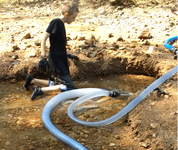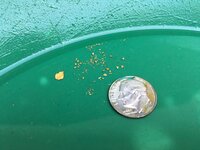brianc053
Hero Member
- Jan 27, 2015
- 987
- 3,443
- 🏆 Honorable Mentions:
- 3
- Detector(s) used
- Minelab Equinox 800
XP Deus 2
- Primary Interest:
- Metal Detecting
Hi all. First the disclaimer: I'm just a paying customer, and have no relationship with the maker of the Hydro-force or the equipment provider I purchased mine from. I offer these opinions because I hope they help others in their research of different dredge nozzle options available.
I feel for the folks in California, because this post - and any mention of people actually dredging - will probably just make you want to get out and dredge. Maybe the moratorium will be lifted soon... Out here on the East Coast there are plenty of states, north and south, that still allow us to dredge, and I hope to take advantage of that (while I can). Also, I'm no expert at dredging; this is just my second year with any experience running a nozzle.
I researched, and eventually purchased, the Hydro-force because I've come across more than a few scenarios where I believe there's probably rarely touched areas - dry areas - in some of the spots I've visited. I read all the reviews, watched all the videos, but what finally convinced me to buy one was talking with another owner last month. He couldn't have been more happy with his nozzle, so I thought I'd give it a try.
I got my 3" Hydro-force nozzle this past week; it's the one with the 2" pressure hose fitting. After picking up 3" suction hose and a short section of 2" conventional pressure hose I headed out yesterday to one of our club's properties where the property owner lets us high bank. I mention the short section of 2" pressure hose because here's the setup: my pump is a Pacer/Briggs&Stratton that puts out 190 GPM and has a 2" outlet. I'm running lay-flat from the pump toward the nozzle, but between the lay-flat and the nozzle is this short, 8' section of conventional pressure hose. I'm told this hybrid/combination of lay-flat and conventional will allow flexibility/maneuverability close to the nozzle, it uses a weight- and cost-conscious combination of hoses and it still allows the water to flow well from the pump all the way to the nozzle. Anyway...
Once I got the pump hooked up out in the field, I wanted to run three tests: basic water flow, wet material suction and then the dry land suction. I was NOT really trying to catch any gold - there's not much gold where our club has properties, and what's there is flour gold at a rate of a few specks every 5 gallon bucket. This is the "practice field", not the game-time stadium.
The basic summary is that all 3 test passed with flying colors. I had no issues whatsoever, other than one rock jam in the 3" suction hose itself (not the nozzle). The nozzle sucked material underwater like another 3" conventional nozzle I've used. As for the dry land test, I cleared out around 3 rocks that were embedded in the bank (not undercutting; near the water's edge) in no time. The nozzle worked exactly as advertised, and you can't ask for more than that.
I don't have pictures - sorry - but the next step is a field test, likely down in Virginia later this month. I'll revisit this post at that time and add some field-test observations.
I hope this helps someone.
- Brian
I feel for the folks in California, because this post - and any mention of people actually dredging - will probably just make you want to get out and dredge. Maybe the moratorium will be lifted soon... Out here on the East Coast there are plenty of states, north and south, that still allow us to dredge, and I hope to take advantage of that (while I can). Also, I'm no expert at dredging; this is just my second year with any experience running a nozzle.
I researched, and eventually purchased, the Hydro-force because I've come across more than a few scenarios where I believe there's probably rarely touched areas - dry areas - in some of the spots I've visited. I read all the reviews, watched all the videos, but what finally convinced me to buy one was talking with another owner last month. He couldn't have been more happy with his nozzle, so I thought I'd give it a try.
I got my 3" Hydro-force nozzle this past week; it's the one with the 2" pressure hose fitting. After picking up 3" suction hose and a short section of 2" conventional pressure hose I headed out yesterday to one of our club's properties where the property owner lets us high bank. I mention the short section of 2" pressure hose because here's the setup: my pump is a Pacer/Briggs&Stratton that puts out 190 GPM and has a 2" outlet. I'm running lay-flat from the pump toward the nozzle, but between the lay-flat and the nozzle is this short, 8' section of conventional pressure hose. I'm told this hybrid/combination of lay-flat and conventional will allow flexibility/maneuverability close to the nozzle, it uses a weight- and cost-conscious combination of hoses and it still allows the water to flow well from the pump all the way to the nozzle. Anyway...
Once I got the pump hooked up out in the field, I wanted to run three tests: basic water flow, wet material suction and then the dry land suction. I was NOT really trying to catch any gold - there's not much gold where our club has properties, and what's there is flour gold at a rate of a few specks every 5 gallon bucket. This is the "practice field", not the game-time stadium.
The basic summary is that all 3 test passed with flying colors. I had no issues whatsoever, other than one rock jam in the 3" suction hose itself (not the nozzle). The nozzle sucked material underwater like another 3" conventional nozzle I've used. As for the dry land test, I cleared out around 3 rocks that were embedded in the bank (not undercutting; near the water's edge) in no time. The nozzle worked exactly as advertised, and you can't ask for more than that.
I don't have pictures - sorry - but the next step is a field test, likely down in Virginia later this month. I'll revisit this post at that time and add some field-test observations.
I hope this helps someone.
- Brian
Last edited:







